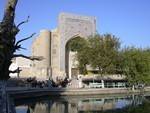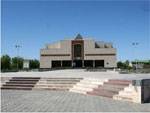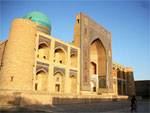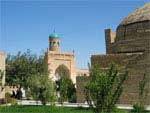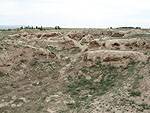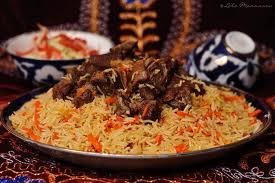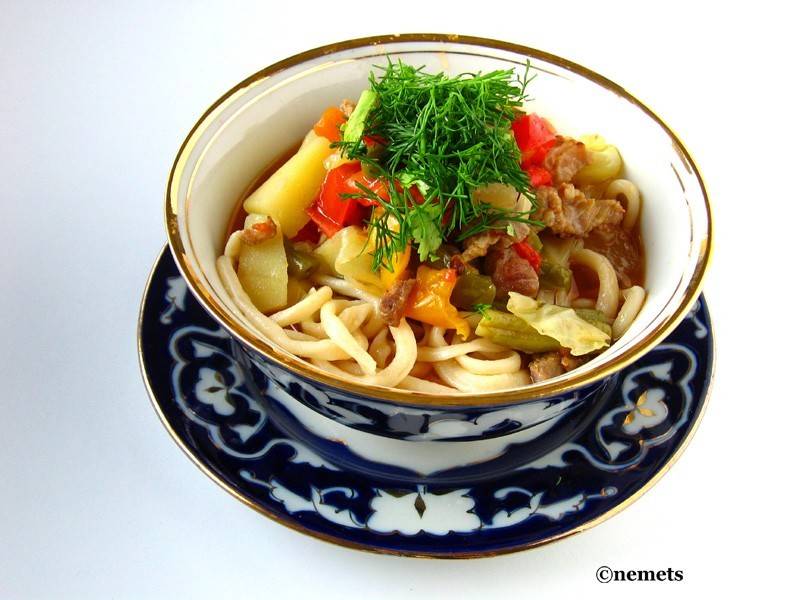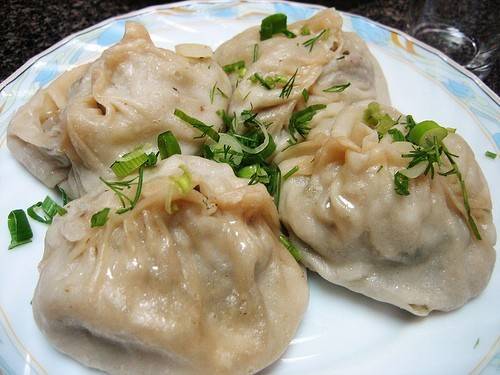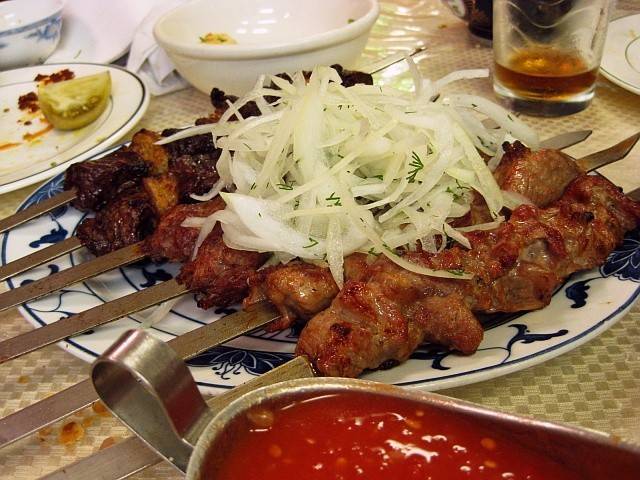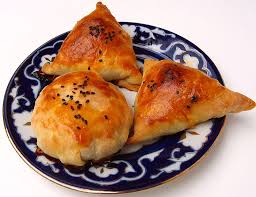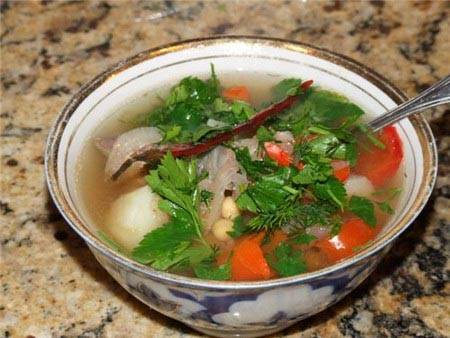Uzbek cuisine
The plentiful fruits and vegetables grown throughout the country define the peak of Uzbek national cuisine and its flavor and fragrances. Food preparation and preserving techniques, handed down for generations, also allow for more creative dishes year round.
Peculiarities of Uzbek cuisine:
Cookery can be considered an applied art. For centuries, Uzbek cuisine has acquired specific features, tastes and genres. The acquaintance with this aspect of national creativity presents great historical and cultural interest. Throughout the ages, the Uzbek people have gained rich experience food preparation by creating hundreds of delicious dishes and delicacies with recipes preserved until today.
The Uzbek dishes are not spicy (hot) although they are tasty. The usage of various spices and greens (black caraway, black and red pepper, barberries, sesame) is significant for preparing delicious dishes. The most popular greens that are used are parsley, dill, celery and basilic. Other spices include vinegar added in salads and for pickling cucumbers, tomatoes and garlic. The following fruits are also used in some food preparation: quince, pomegranate, fresh and dried plum, alycha (damson) and sultana (raisins).
Uzbek cuisine numbers over one hundred kinds of pilaf, 30 kinds of shahshlik, 70-80 different soups, various types of bread, samsa, floured food, confectionary, etc. National Uzbek cuisine offers a wide choice of dishes and usually washed down with a few cups of the national Uzbek drink, green or black tea.
Seasonal food:
Uzbek cuisine does have seasonal dishes including salad with radish and sour-cream, sumalak, dumplings with greens, samsa with greens, meet rolls with grapes leaves, roast beef and cauliflower, and lentil soup with mint which are made mostly in the spring. Shashlik with tomatoes, meat rolled in cabbage leaves, stuffed peppers, lagman, cold soup of sour milk, stewed meat and vegetables, ayran, tea and compotes are made mostly in summer. Fried meat, fish shashlik, roastbeef of lamb, quail soup, plov with quince, manti with potatoes or pumpkin are made mostly in autumn. Various plovs (kazi-karta, postdumba), lamb shashlik salad with green radish, soups, lentil porridge, different dried fruits, jams, compotes, various pickled vegetables are made in the winter.
Some special dishes are cooked only for wedding parties or other holidays such as kazi-karta, postdumba uramasi (roll of fat tail), tandir kabob (baked kabob), norin (horsemeat with noodles), khasip (domestic sausage).
Uzbek bread
The majority of Uzbek breads are baked in special ovens called tandirs. Tandir baking is a guarantee for wonderful qualities of bread. The process of baking in a tandir takes 4-8 minutes. The wide-spread type of Uzbek bread, obi-nan, is baked from common dough with a special leaven. It is leaven that gives the bread its excellent taste. The diversity of Uzbek breads is astonishing. Besides the most common obi-nan and 'patyr' (thin bread) made of short pastry with sheep's fat, there exist unique kinds of breads that are baked more seldom and may seem exotic even for the local population. Each region can boast of its own bread being unique. Each bread has its own leaven, its original technique of baking and marvelous taste.
The bread gala-osiyogi-nan that is baked in the village of Gala-Osiyo near Samarkand is famous all over the world. Every visitor, by all means tries to buy this bread before leaving the city. This bread is unique for its taste and nourishing qualities. The Ferghana valley is famed for its tasty layer-breads - katlama. Each layer is covered with oil and sour cream. Breads can also be made of corn flour (zogora nan), and herbs (kuk patyr).
Traditionally people do not cut bread with knives; they break it with their hands. Table etiquette prohibits to put broken pieces of bread "face" down. This disrespects the bread in Uzbek culture, since bread symbolizes life.
One custom that involves bread occurs when a relative is leaving home. The relative will take half of a piece of break with him or her, and the other half stays at the home until their return. During an engagement, bread breaking is performed for making the future marriage of the bride and groom strong and stable. In Uzbekistan bread is God's bliss, from ancient times people have worshipped and respected it.
Famous Uzbek dishes Plov (pilaf)
Bread and salad of fresh tomatoes and onions are always served with plov.
Uzbek people for centuries have used classical technology for preparing plov. There are plenty of variations of the dish. Gourmands prefer Samarkand, Bukhara and Khoresm variants of plov especially. Special plov is cooked for wedding ceremonies. Each region in Uzbekistan has its own secret way of cooking this dish. These secrets create a cornucopia of taste and flavor.
Lagman
Afterwards the noodles and vadja are mixed together. Ready noodles are placed on the bottom of deep bowl and then layers of vadja and greens, garlic and pepper are poured on top of the noodles according to one's taste.
Sumalak
Legends about the origin of this dish:
There are several legends about the origin of sumalak.
Once nomads from the east tired to besiege the town-fortress on the bank of Jeykhun. When the dwellers had run out of food during the invasion, the elders ordered to bring the last sacks of damp wheat to prepare. When the town's defenders tried the unattractive food, they felt such burst of energy and that they resisted the invaders furiously. The invaders could not match the strength of the town dwellers and retreated. Peace came to the land again.
A farmer preparing to sow wheat moistened the seeds. They grew, but at this moment, the weather turned for the worse. The farmer asked his wife to make porridge from those seeds. After boiling for a long time, the food was ready. The husband was very pleased with the dish. Since that time, sumalak has been cooked every year throughout Central Asia.
Manty
Then the manty is basted with oil and put into the layers of the special steam pot. The delicious food takes 30-35 minutes to cook. Ready manty are placed into a large dish. They may be seasoned with sour cream or meat broth, black pepper or greens.
Kebab a -la-Uzbek:
To cook lyulya you should mince the mutton and onions together in a mincing mashine. This mix is then specially spiced. Four long cylinders in the shape of a cucumber are made and then formed onto a metallic stick and roasted over hot coals. This is an incredibly delicious dish, and one of the favorites of tourists.
Samsa (samosa)
The pinched side of the samsa is put on tandir's wall. Then tandir is firmly covered and in 20 minutes, the top is opened and at the bottom of the tandir the fire is extinguished, and the samsa is left in the tandir for another 10-15 minutes. Samsa is then served hot and is really a pleasure to eat!
Pieva (onion soup)
Onion soup is a typical soup for all Central Asian cookery. However, the recipes for making this soup may vary. Uzbeks cook pieva with meat; the onion quantity is usually three times larger than the quantity of meat. Bitter onion is preferable for this kind of soup. Then water is added (two times more than the onion quantity).
You should add small pieces of fat, chopped onions, cut meat and tomatoes and fry everything for 20 minutes. Then cold water should be added and let to boil for 30 minutes on a small flame. When the food is practically ready, the spices should be added. Pieva is eaten with insipid dry flat cakes which are thrown into the soup (similar to croutons).
Shurpa
It increases one's appetite while eating, due to the spices added and way of cooking. Shurpa is cooked on a small flame like other Central Asian soups. The meat is cooked during 1-2 hours then the vegetables are added and cooked for another 30-45 minutes. When ready, shurpa must have a thick broth (brownish-red in color) and smell of pepper and spices.
Chuchvara -Uzbek dumplings
True Uzbek chuchvara is fried in vegetable oil which distinguishes it from Russian dumplings. Vinegar, greens, sour cream, tomato sauce, paprika and hot pepper can also be added to chuchvara.


